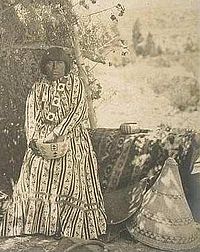- Kucadikadi
-
Kucad ikadi Bandmember Nellie Charlie, early 20th c.
Bandmember Nellie Charlie, early 20th c.
Regions with significant populations  United States (
United States ( California)
California)Languages Religion Traditional Tribal Religion, Christianity
Related ethnic groups other Northern Paiute people, Mono tribe (including Owens Valley Paiute),[1] Western Shoshone, Yokuts
The Kucad
ikadiare a band of Northern Paiute people who live near Mono Lake in Mono County, California. They are the southernmost band of Northern Paiute.[2][3]Contents
Name
Kucad
ikadimeans "eaters of the brine fly pupae." They are also known as the Kutsavidökadö, Koza'bittukut'teh, Kotsa'va, Mono Lake Paiute,[4] Mono Basin Paiute,[3] and Kuzedika.[1] The term "Mono Lake Paiute," a holdover from early anthropological literature, has proven problematic.[5]Culture and geography
The Kucad
ikadi's homeland surrounds Mono Lake in eastern California, but they traditionally traveled to Walker Lake, Nevada for seasonal subsistence activities. Mono Lake is a high piedmont area of the Sierra Nevada Mountains. The average elevation of the Mono Lake basin is around 6,400 feet above sea level. The surrounding mountains range from 9,000 to 13,000 feet in elevation. Mono Lake is extremely saline and is home to several waterfowl species and the brine fly, or Ephydra hians or Hydropyrus hians,[3] from which the band takes its name.[2] Pinus monophylla or Piñon pine has been an importance source of food, as were jackrabbits, deer, mountain sheep, and the Coloradia pandora moth.[1]The extended family was the bands basic social units, which moved together as a group. They traded with Owens Valley Paiute[1] and Western Mono.
Three late 19th century winter houses belonging to the tribe have been excavated by archaeologists. They are conical houses constructed with posts of Utah juniper or Juniperus osteosperma. Winter of houses of this type, called tomogani, were built by the band up to 1920.[3]
Language
The Kucad
ikadispeak the Northern Paiute language, which is in the Numic branch of the Uto-Aztecan language family.[6]Basketry
The band is well known for its basketry. They wove coiled baskets as well as twined baskets.[7] Bracken fern and redbud provide color for designs on coiled baskets.[8]
In the late 19th century and early 20th century, encroachment of non-Natives in their territory disrupted traditional hunting and gathering lifestyles, so members of the tribe relied on the tourist trade. Selling elaborate baskets to non-Indian tourists became viable way of making a living.
Glass beads were introduced by non-Indians, and Kucad
ikadiwomen began incorporating the seed beads into their baskets by 1908.[8]Today
Many members of the Kucad
ikadiband are enrolled in federally recognized Paiute, Washoe, Yokuts, Miwok, and Western Mono tribes. Others are seeking recognition as the Sierra Southern Miwuk[9] and the Mono Lake Indian Community, headquartered in Lee Vining, California.[10]Notable Kucad
ikadi- Carrie Bethel (1898–1974), basket weaver
- Nellie Charlie (1867–1965), basket weaver
- Lucy Telles ((ca. 1870/1885–1955/6), basket weaver
Notes
- ^ a b c d Busby, Colin I., John M. Findlay, and James C. Bard. "A Culture Resource Overview of the Bureau of Land Management Coleville, Bodie, Benton, and Owens Valley Planning Units, California." Bureau of Land Management, California. (retrieved 1 Sept 2010)
- ^ a b Fowler and Liljeblad 437
- ^ a b c d Arkush, Brooke S. "Historic Northern Paiute Winter Houses in Mono Basin, California." Journal of California and Great Basin Anthropology. 9 (2) 1987 (retrieved 31 Aug 2010)
- ^ Fowler and Liljeblad 464
- ^ Kelly and Fowler 394
- ^ Pritzker 224
- ^ Dalrymple 33
- ^ a b Dalrymple 35
- ^ "Brian Bibby, California Indian ethnologist, gets it right the first time about Yosemite Indians." Modesto Bee: The Hive. 18 Jan 2008 (retrieved 31 Aug 2010)
- ^ "California Indians and Their Reservations." SDSU Library and Information Access. (retrieved 1 Sep 2010
References
- Fowler, Catherine S. and Sven Liljeblad. "Northern Paiute." Handbook of North American Indians: Great Basin, Volume 11. Washington, DC: Smithsonian Institution, 1986. ISBN 978-0160045813.
- Kelly, Isabel T. and Catherine S. Fowler. "Southern Paiute." Handbook of North American Indians: Great Basin, Volume 11. Washington, DC: Smithsonian Institution, 1986: 368-397. ISBN 978-0160045813.
- Pritzker, Barry M. A Native American Encyclopedia: History, Culture, and Peoples. Oxford: Oxford University Press, 2000. ISBN 978-0-19-513877-1
External links
- "Native American Story of Mono Lake Paiute," Reznet News video
Categories:- Native American tribes in California
- Native American history of California
- Mono County, California
- Paiute
Wikimedia Foundation. 2010.


